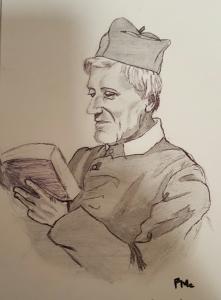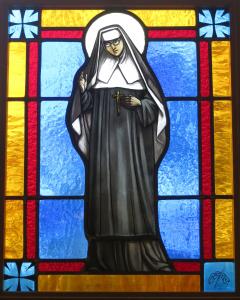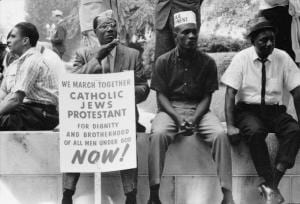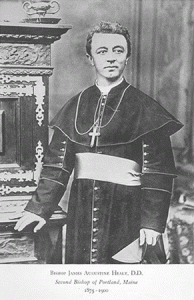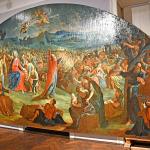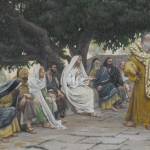 Matteo Ricci, SJ (October 6, 1552 – May 11, 1610) was an Italian Jesuit priest. Matteo Ricci was born in 1552 in Macerata, then part of the Papal States. Ricci started learning theology and law in a Roman Jesuits’ school. In 1577, he filed an application to be a member of a Missionary to India, and his journey began in March 1578 from Lisbon, Portugal. He arrived in Goa, a Portuguese Colony, in September 1578, and four years later he was dispatched to China. In 1582, Ricci started learning the Chinese language and customs in Macao, a Portuguese trading post in Southern China, and became a rare Western scholar who had mastered Chinese classical script. The next year saw Ricci move inland and, after a visit to Canton, settle in Zhaoqing (肇慶) in Guangdong Province. Ricci moved there after receiving an invitation from the governor of Zhaoqing at the time, Wang P’an, who had heard of Ricci’s skill as a mathematician/cartographer. Ricci stayed there from 1583 to 1589 before having to leave after a new viceroy decided to expel him. It was in Zhaoqing, in 1584, that Ricci composed the first European-style map of the world in Chinese. It is thought that during this time (1583-88) Ricci, together with Michele Ruggieri, compiled their Portuguese-Chinese dictionary – the first ever European-Chinese dictionary, for which they developed a consistent system for transcribing Chinese words in Latin alphabet. Unfortunately, the manuscript was misplaced in the Jesuit Archives in Rome, and not re-discovered until 1934. This dictionary was finally published in 2001. Further travels in China saw Ricci reach Nanjing and Nanchang in 1595. In August 1597, Alessandro Valignano (1539-1606), his superior, appointed him as Major Superior of the mission in China, with the rank and powers of a Provincial, a charge that he fulfilled until his death.[3] He moved to Tongzhou (a port for Beijing) in 1598 and then first reached Beijing on the 7th September 1598. However, because of a Korean/Japanese war at the time, Ricci could not reach the Imperial Palace. After waiting for two months he left Beijing first for Nanjing and also stopped at Suzhou in Jiangsu Province. During the winter of 1598, Ricci, with the help of his Jesuit colleague Lazzaro Cattaneo, compiled another Chinese-Portuguese dictionary, in which tones of the romanized Chinese syllables were indicated with diacritical marks. This work has been lost, and, unlike Ricci’s and Ruggieri’s earlier Portuguese-Chinese dictionary, has never been found. In 1601 he returned to Beijing where he was not initially granted an audience with the Emperor of China but, after he presented the Emperor with a chiming clock, Ricci was finally allowed to present himself at the Imperial court of the Wanli Emperor thus becoming the first Westerner to be invited into the Forbidden City. Although Ricci was given free access to the Forbidden City he never met the Wanli Emperor; however, Wanli did grant him patronage by allotting to Ricci a generous stipend that helped the Jesuits in China. Ricci was able to meet important officials and leading members of the Beijing cultural scene. Ricci lived on in China until the end of his life. He died in Beijing on May 11 1610 at the age of 58. According to the code of the Ming Dynasty, foreigners who died in China had to be buried in Macao. The Jesuits made a special plea to the court, requesting a burial plot in Beijing in view of Ricci’s contributions to China. Emperor Wanli of the Ming Dynasty granted his permission and designated a Buddhist temple for the purpose. In October of 1610, the Jesuit Father’s remains were transferred to the tomb.The tombs of Ferdinand Verbiest, Johann Adam Schall von Bell, and other missionaries are also in the same location, which became known as the Zhalan cemetery (Chinese: 栅栏墓地; pinyin: Zhàlán Mùdì) and is now on the campus the Beijing Administrative College (located at 6 Chegongzhuang Road, Xicheng District, Chinese: 西城区车公庄大街6号; pinyin: Xīchéng Qū Chēgōngzhuāng Dàjiē 6Hào). Matteo Ricci was replaced as Superior General of the China mission by Nicolò Longobardo in 1610. Ricci could speak Chinese as well as read and write classical Chinese, the literary language of scholars and officials. Added to this he was known for his appreciation of Chinese culture. During his research he discovered that, in contrast to the cultures of South Asia, Chinese culture was strongly intertwined with Confucian values and therefore decided to use existing Chinese concepts to explain Christianity. He refused to explain the Catholic faith as something foreign or new, instead, he confirmed that the Chinese culture and people always believed in God, and that Christianity is simply the most perfect manifestation of their faith. Thus the Chinese Lord of Heaven is identical with Jesus Christ. He supported Chinese traditions by agreeing with the veneration of the dead. Dominican and Franciscan missionaries felt he went too far in accommodation and convinced the Vatican to outlaw Ricci’s approach. Similarly to developments in India, the identification of European culture with Christianity led to the virtual end of Catholic missions in China. Later discovering that Confucian thought was dominant in Ming Dynasty, Ricci became the first to translate the Confucian classics into a western language, Latin, with assistance from the scholar Xu Guangqi.
Matteo Ricci, SJ (October 6, 1552 – May 11, 1610) was an Italian Jesuit priest. Matteo Ricci was born in 1552 in Macerata, then part of the Papal States. Ricci started learning theology and law in a Roman Jesuits’ school. In 1577, he filed an application to be a member of a Missionary to India, and his journey began in March 1578 from Lisbon, Portugal. He arrived in Goa, a Portuguese Colony, in September 1578, and four years later he was dispatched to China. In 1582, Ricci started learning the Chinese language and customs in Macao, a Portuguese trading post in Southern China, and became a rare Western scholar who had mastered Chinese classical script. The next year saw Ricci move inland and, after a visit to Canton, settle in Zhaoqing (肇慶) in Guangdong Province. Ricci moved there after receiving an invitation from the governor of Zhaoqing at the time, Wang P’an, who had heard of Ricci’s skill as a mathematician/cartographer. Ricci stayed there from 1583 to 1589 before having to leave after a new viceroy decided to expel him. It was in Zhaoqing, in 1584, that Ricci composed the first European-style map of the world in Chinese. It is thought that during this time (1583-88) Ricci, together with Michele Ruggieri, compiled their Portuguese-Chinese dictionary – the first ever European-Chinese dictionary, for which they developed a consistent system for transcribing Chinese words in Latin alphabet. Unfortunately, the manuscript was misplaced in the Jesuit Archives in Rome, and not re-discovered until 1934. This dictionary was finally published in 2001. Further travels in China saw Ricci reach Nanjing and Nanchang in 1595. In August 1597, Alessandro Valignano (1539-1606), his superior, appointed him as Major Superior of the mission in China, with the rank and powers of a Provincial, a charge that he fulfilled until his death.[3] He moved to Tongzhou (a port for Beijing) in 1598 and then first reached Beijing on the 7th September 1598. However, because of a Korean/Japanese war at the time, Ricci could not reach the Imperial Palace. After waiting for two months he left Beijing first for Nanjing and also stopped at Suzhou in Jiangsu Province. During the winter of 1598, Ricci, with the help of his Jesuit colleague Lazzaro Cattaneo, compiled another Chinese-Portuguese dictionary, in which tones of the romanized Chinese syllables were indicated with diacritical marks. This work has been lost, and, unlike Ricci’s and Ruggieri’s earlier Portuguese-Chinese dictionary, has never been found. In 1601 he returned to Beijing where he was not initially granted an audience with the Emperor of China but, after he presented the Emperor with a chiming clock, Ricci was finally allowed to present himself at the Imperial court of the Wanli Emperor thus becoming the first Westerner to be invited into the Forbidden City. Although Ricci was given free access to the Forbidden City he never met the Wanli Emperor; however, Wanli did grant him patronage by allotting to Ricci a generous stipend that helped the Jesuits in China. Ricci was able to meet important officials and leading members of the Beijing cultural scene. Ricci lived on in China until the end of his life. He died in Beijing on May 11 1610 at the age of 58. According to the code of the Ming Dynasty, foreigners who died in China had to be buried in Macao. The Jesuits made a special plea to the court, requesting a burial plot in Beijing in view of Ricci’s contributions to China. Emperor Wanli of the Ming Dynasty granted his permission and designated a Buddhist temple for the purpose. In October of 1610, the Jesuit Father’s remains were transferred to the tomb.The tombs of Ferdinand Verbiest, Johann Adam Schall von Bell, and other missionaries are also in the same location, which became known as the Zhalan cemetery (Chinese: 栅栏墓地; pinyin: Zhàlán Mùdì) and is now on the campus the Beijing Administrative College (located at 6 Chegongzhuang Road, Xicheng District, Chinese: 西城区车公庄大街6号; pinyin: Xīchéng Qū Chēgōngzhuāng Dàjiē 6Hào). Matteo Ricci was replaced as Superior General of the China mission by Nicolò Longobardo in 1610. Ricci could speak Chinese as well as read and write classical Chinese, the literary language of scholars and officials. Added to this he was known for his appreciation of Chinese culture. During his research he discovered that, in contrast to the cultures of South Asia, Chinese culture was strongly intertwined with Confucian values and therefore decided to use existing Chinese concepts to explain Christianity. He refused to explain the Catholic faith as something foreign or new, instead, he confirmed that the Chinese culture and people always believed in God, and that Christianity is simply the most perfect manifestation of their faith. Thus the Chinese Lord of Heaven is identical with Jesus Christ. He supported Chinese traditions by agreeing with the veneration of the dead. Dominican and Franciscan missionaries felt he went too far in accommodation and convinced the Vatican to outlaw Ricci’s approach. Similarly to developments in India, the identification of European culture with Christianity led to the virtual end of Catholic missions in China. Later discovering that Confucian thought was dominant in Ming Dynasty, Ricci became the first to translate the Confucian classics into a western language, Latin, with assistance from the scholar Xu Guangqi.
Ricci also met a Korean emissary to China, Yi Su-gwang. He taught Yi Su-gwang the basic tenets of Catholicism and transmitted western knowledge to him, giving Yi Su-gwang several books from the west that became the basis of his later works. Ricci’s transmission of western knowledge to Yi Su-gwang influenced and helped shape the foundation of the Silhak movement in Korea.
(Adapted from Wikipedia)


